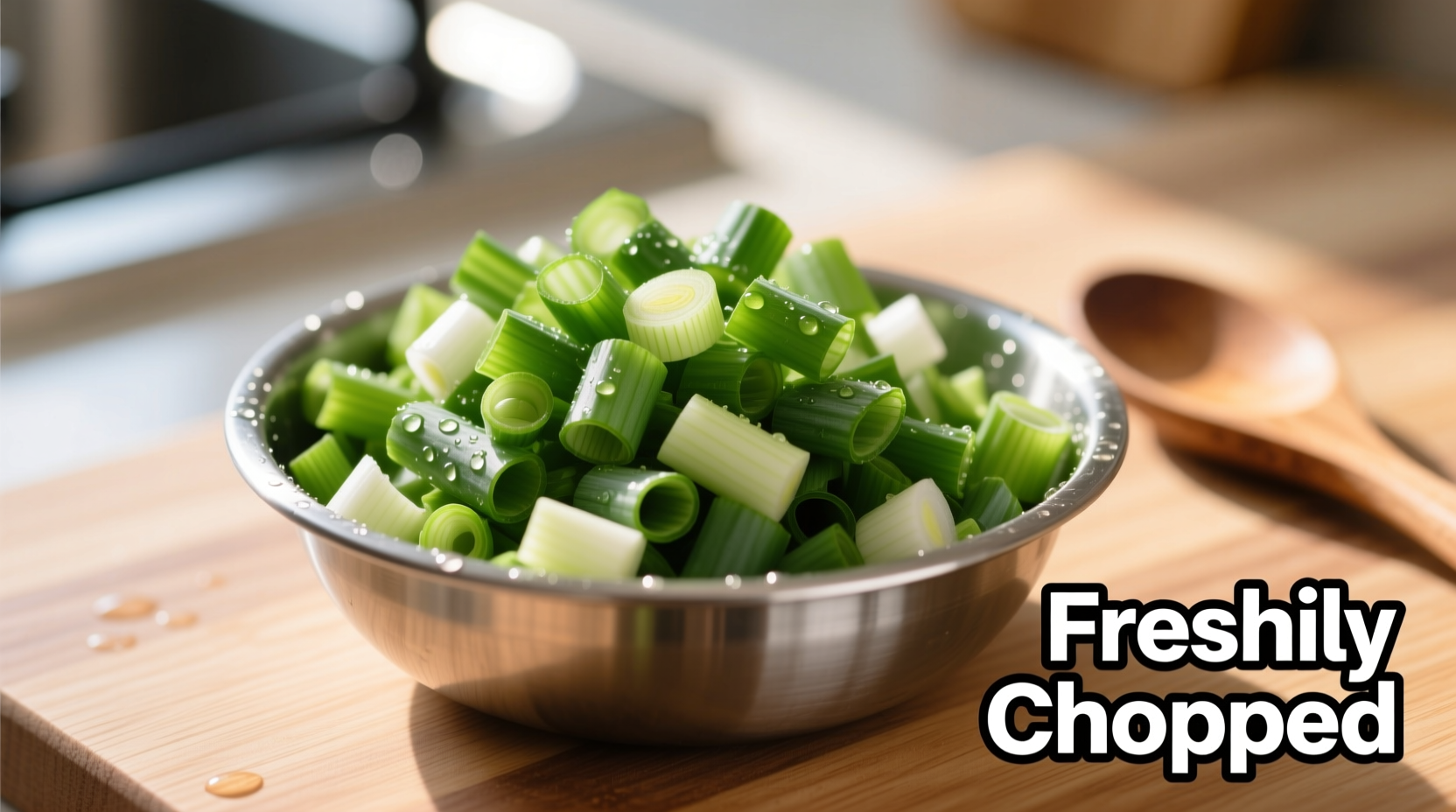The Essential Guide to Chopped Green Onions: Technique, Uses & Storage
When a recipe calls for chopped green onions, understanding the proper technique and application makes all the difference in your cooking. This comprehensive guide reveals professional methods for preparing, using, and storing this versatile ingredient to elevate your everyday meals with restaurant-quality results.
What Exactly Are Chopped Green Onions?
Green onions (also called scallions) consist of a white bulb end that gradually transitions to hollow green stalks. When recipes specify chopped green onions, they typically mean the entire stalk cut into uniform pieces. The white portion offers a sharper, more pungent flavor similar to onions, while the green section provides a milder, grassy note perfect for garnishing.

Why Proper Chopping Technique Matters
Incorrectly chopped green onions can ruin a dish's texture and flavor balance. Professional chefs emphasize these key considerations:
- Consistent size ensures even flavor distribution
- Separating white and green parts allows for strategic cooking application
- Clean cuts prevent bruising that releases excessive sulfur compounds
- Proper washing removes hidden dirt between layers
Step-by-Step: Chopping Green Onions Like a Professional
Follow this chef-approved method for perfect chopped green onions every time:
- Preparation: Trim root ends and any wilted tips. Soak in cold water for 2 minutes to remove hidden soil.
- Drying: Pat thoroughly with clean kitchen towel - wet onions won't chop cleanly.
- Positioning: Lay onions flat on cutting board. For uniform pieces, stack 3-4 onions before cutting.
- Cutting technique: Use a rocking motion with a sharp chef's knife, creating 1/8-inch slices for most applications.
- Separation: For recipes specifying "white parts only" or "green parts only," simply divide at the natural color transition point.
Measurement Equivalents: How Much Is a Cup of Chopped Green Onions?
Understanding measurements prevents recipe failures. This verified conversion chart comes from USDA FoodData Central and culinary testing:
| Whole Green Onions | Chopped White Parts | Chopped Green Parts | Total Chopped |
|---|---|---|---|
| 4 medium (6-7" long) | ¼ cup | ½ cup | ¾ cup |
| 6 medium (6-7" long) | ⅓ cup | ⅔ cup | 1 cup |
| 10 medium (6-7" long) | ½ cup | 1 cup | 1½ cups |
Culinary Applications: Maximizing Flavor Impact
Understanding when to use each part transforms your cooking:
White Parts: The Flavor Foundation
Add during cooking for dishes like:
- Stir-fries (add with garlic and ginger)
- Soups and stews (early in cooking process)
- Omelets and scrambled eggs (sauté before adding eggs)
Green Parts: The Finishing Touch
Add at the end for:
- Garnishing tacos, baked potatoes, and soups
- Mixing into dips and spreads
- Adding to rice dishes just before serving
Storage Techniques for Maximum Freshness
Proper storage extends usability of chopped green onions significantly. Research from the University of California Cooperative Extension shows these methods:
| Storage Method | Freshness Duration | Best For |
|---|---|---|
| Whole in plastic bag with damp paper towel | 10-14 days | Future chopping needs |
| Chopped in airtight container with paper towel | 3-4 days | Immediate use |
| Frozen in oil cubes | 2-3 months | Cooking applications (not garnish) |
Nutritional Benefits You Should Know
According to USDA FoodData Central, one cup (92g) of chopped green onions provides:
- 32 calories
- 117% of daily vitamin K
- 27% of daily vitamin C
- Significant vitamin A and folate
- Antioxidants like allicin and quercetin
Unlike mature onions, green onions retain higher levels of chlorophyll and certain phytonutrients in their green portions, making the entire stalk nutritionally valuable.
Common Mistakes to Avoid
Even experienced cooks make these errors with chopped green onions:
- Using dull knives - crushes rather than cuts, releasing excessive sulfur
- Adding green parts too early - causes them to wilt and lose vibrant color
- Improper washing - misses dirt trapped between layers
- Storing in water - promotes rapid spoilage (use damp paper towel instead)
When Substitutions Make Sense
While nothing perfectly replaces chopped green onions, these alternatives work in specific contexts:
- Chives - for garnish only (milder flavor, different texture)
- Shallots - when stronger onion flavor is acceptable
- Leeks - for cooked applications requiring similar mild onion flavor
- Red onion - when color contrast is desired (use sparingly)











 浙公网安备
33010002000092号
浙公网安备
33010002000092号 浙B2-20120091-4
浙B2-20120091-4